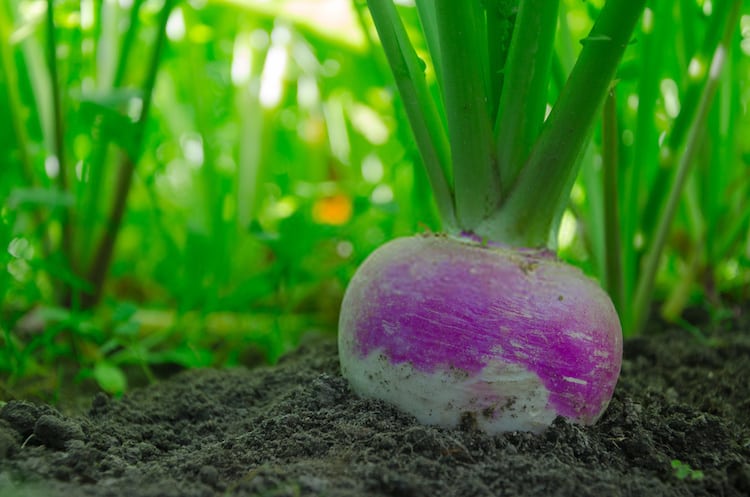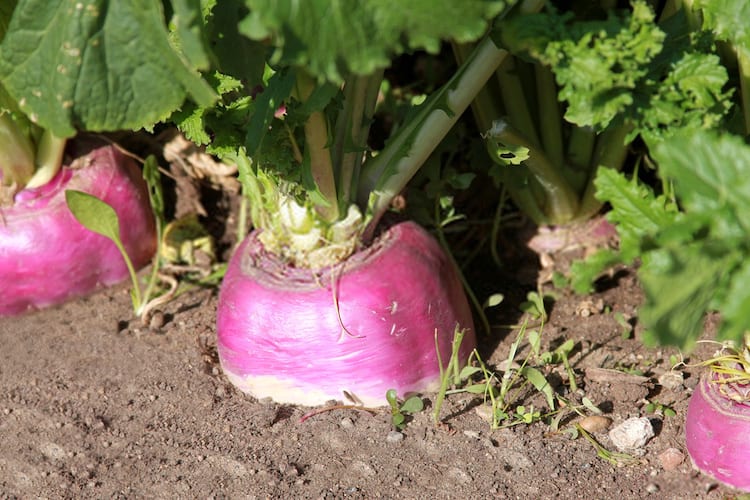If you've ever wanted to learn how to grow turnips from scraps, this is the best guide for you.
The pursuit of eating healthy and buying fresh produce is a constant goal for most households. Grocery shopping for fresh produce is expensive, but there is a way out. There are many vegetables you can regrow from scraps, and an example is the turnips greens.
While this may not eliminate your living expenses, it can still help you reduce organic waste in your home, save money, and practice food sustainability all in one trial.
In today's article, you're going to learn how to easily grow turnip from scraps and also experiment with other similar vegetables.
Read Also: When to Harvest Turnip Greens
Table of Contents
Why Grow Turnips from Scraps?
The turnip is a highly nutritious plant known for its low-calorie density and its high nutrient count. Turnips contain a host of vitamins ranging from vitamins K, A, C, E, B1, B3, B5, B6, B2 and they are also loaded with fiber as well as minerals, such as:
- Potassium
- Manganese
- Calcium magnesium
- Iron
- Copper
They are also a good source of phosphorus, omega-3 fatty acids, and protein, which makes it a perfect addition to your family's healthy eating plan.
This plant belonging to the cruciferous family is made of wonders. Imagine having a countless supply of this beneficial farm produce at your beck and call.
Apart from wanting to have an unlimited supply of your favorite healthy greens, there are many other fun reasons to grow turnips from scrap, which include:
- Reduce food waste: Converting turnip scraps into a plant garden is a way of reducing the statics of the level of food waste.
- Save money: Growing turnips from scraps help save money; that way, you only harvest when you need them. Re-growing will help save up the money spent on fresh produce during grocery shopping that ends up unused.
- Teach the younger generation: If you have children, get them to join you in organizing and participating in projects like this. In return, you will be raising a generation of people that are aware of the source of the food they eat, how they grow, and an understanding of nature and sustainability by using the natural processes to their advantage.
- Eat more healthily: When you buy turnips produce from the grocery store and then use the scraps to regrow more at home, you are more confident of the authenticity of the food you eat and how organic they are.
- Have fun: What's not to love about this simple DIY planting? It can also serve as a stress relief exercise.
What Part of the Plant to Regrow: Sorting Out Turnip Scraps
For greens such as turnips, the fleshy root gets eaten, and the top part, where leaves once grew, gets thrown in the waste. These top when regrown produces tasty leaves for side dishes and fresh salads.
Generally, all roots plants, including turnips, are easy to grow, and leftover turnip scraps are not an exemption. All you need to do is to retain the tops of the turnip and place it in a container of water.
You should notice new green tops sprouting out in just a matter of days after you started. Only allow the root to continue growing for about a week.
After a week or thereabout, it should be ready to be transplanted in the ground. You can begin to harvest greens as they grow or allow the roots to keep growing until they are prepared to be transplanted back into the ground. This method works with many other root vegetables, such as parsnips.
How to Grow Turnips From Scraps
Even though there may be some slight changes to the rule, when it comes to growing turnips from scraps, the fundamental steps are often the same. In nature, plants always grow a particular way, all the time.
Before planting, ensure to cut out any turnips parts that are rotten or soft. It only keeps about ½ inch of the fresh sprouting turnip that is still strong.
Also, If you have stored turnips in the refrigerator that are germinating new leaves, you can regrow these to grow turnip greens and yield new seeds for the next cool-weather crop season.
Soil Preparation and Spacing
When planting the turnip scrap (either in a container or a garden bed), the soil has to be prepared just as you would if you were planting turnips from seed.
You should compensate the soil with nutrients by cultivating about 3 or 4 inches of organic compost or manure into 7 to 8 inches of soil.
You can replace organic compost fertilizer if you don't have any at your disposal. Root the top of the turnip scrap (the part with the bud) and pointy tips down with green leaves above the soil.
Ensure to space them at least three inches apart in width and rows about six to eight inches apart. Spacing contributes to the production of robust, leafy produce.
Read Also: Advantages of Perlite
Growing Turnips from Scraps
When growing turnips from scraps, the factors that support growth are the same as usual; water and sunlight.
Turnips are sun-loving plants, and as such, they require an area with full sun, which is to say six to eight hours of sunlight every day. For indoor turnips, this can be achieved by placing the vegetables near a window where they can receive natural sunlight.
They also need constant watering. For turnips to thrive optimally, they require at least 1 inch of water every week. When planting turnips during the dry seasons, you can achieve this by drenching the turnip rows with water each week.
In extremely dry areas, you may make exemptions to the once in a week rule by watering more than once a week.
The key is to study your plants carefully; a soil moisture meter may come in handy here. Look out for unusual looks and posture; wilting leaves are a sign of thirsty turnip plants. If you notice limp or wilting leaves, the turnips need more water.
Read Also: Best Companion Plants for Turnips
Conclusion
Growing turnips from scrapes are one of the many ways to use nature's natural process to your advantage.
With no single doubt, turnip greens have been a staple food for households for generations because of its countless health benefits.
Fresh produce is vital for optimal health, but it gets costly to buy them from the grocery store or market every week.
How about you reduce the level of organic waste, save money, and promote food sustainability with this handy guide on how to grow turnips from scraps.
While you may have thought of turnip scraps as waste, I hope this guide has have proven to you that these items can be regrown and enjoyed all over again.







Leave a Reply